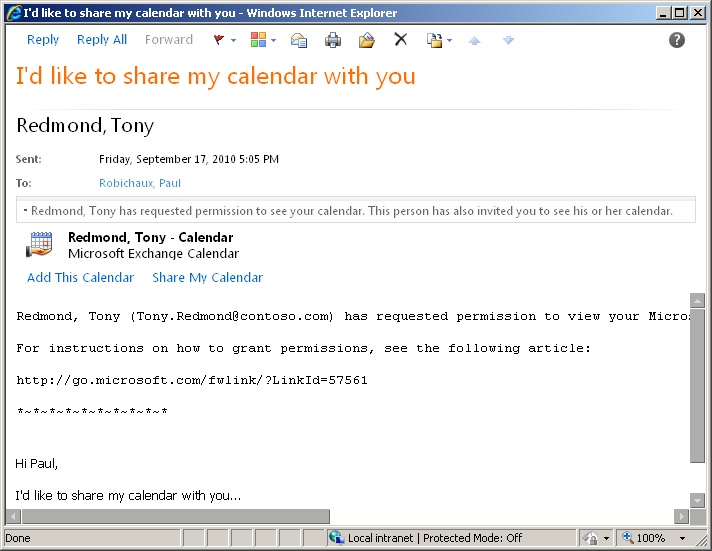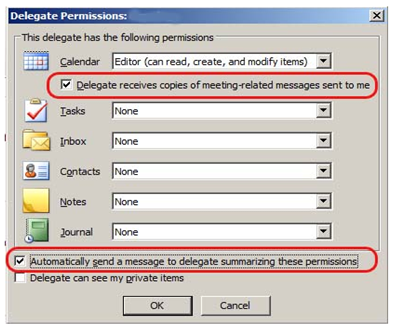
- #EXCHANGE 2010 CALENDAR PERMISSIONS HOW TO#
- #EXCHANGE 2010 CALENDAR PERMISSIONS UPGRADE#
- #EXCHANGE 2010 CALENDAR PERMISSIONS DOWNLOAD#
#EXCHANGE 2010 CALENDAR PERMISSIONS UPGRADE#
Migrate Public Folders to Office 365 by using Outlook PST exportįor Exchange 2003 users, we strongly recommend that you upgrade your on-premises servers to Exchange 2010 SP3 RU8 or later/Exchange 2007 SP3 RU15 or later, and use batch migration, which is the only supported public folder migration method.

Set the permissions on the public folders using the EAC. Export and import the PST files using Outlook.Ħ. Use the New-PublicFolder cmdlet to create the top-most public folder in each of the public folder mailboxes by using the Mailbox parameter.ĥ.

Create the public folder mailboxes that you’ll need based on the mapping file. This file is used to calculate the correct number of public folder mailboxes in Exchange Online.ģ. csv files to create the public folder-to-mailbox mapping file. PublicFolderToMailboxMapGenerator.ps1 file.
#EXCHANGE 2010 CALENDAR PERMISSIONS DOWNLOAD#
If you still want to migrate your public folders by using PST files, follow these steps to ensure a successful migration.ĭownload the migration scripts To download the migration scripts, you only need to download the Capture the current permissions before migration and manually add them back once the migration is completed.Ģ) If you use complex permissions or have many folders to migrate, we recommend that you use the cmdlet method for migration.ģ) Any item and folder changes made to the source public folders during the PST export migration will be lost. In addition, please note the following before using Outlook PST to export public folders to Office 365 or Exchange Online:ġ) Public folder permissions will be lost during this process. Office 365 public folder mailbox growth is managed using an auto-split feature that splits the public folder mailbox when it exceeds size quotas.Īuto-split can’t handle the sudden growth of public folder mailboxes when you use PST export to migrate your public folders and you might have to wait for up to two weeks for auto-split to move the data from the primary mailbox. Click Calendar Icon in lower left corner In the left side bar Right Click the calendar you want to share, then click Properties. However, we don't recommend that you use Outlook’s PST export feature to migrate public folders to Office 365 or Exchange Online if your on-premises public folder hierarchy is greater than 30

$mailboxes = Get-Mailbox -ResultSize Unlimited | Where-Object).Based on my test, you can do the same thing for Public Folders. Quite a bit, this is what i use now and it works.
#EXCHANGE 2010 CALENDAR PERMISSIONS HOW TO#
Pat Richards has posted an excellent post on how to automatically modify new mailboxes using the Scripting Agent. While this script could be scheduled to run on a regular basis, a better approach for managing calendar permissions for new mailboxes are the use of the Scripting Agent which is a part of the Cmdlet Extension Agents, a very useful feature introduced in Exchange Server 2010. Since it`s now possible to manage calendar permissions using PowerShell, I`ve written a script to accomplish this task Set-CalendarPermissions.ps1. Some companies have a policy that everyone must share their calendars with all users. To grant “Reviewer”-permissions for the “Default” user, we would run the following: Since I`ll be focusing on managing default permissions, which is an existing ACL on the calendar folder, we need to use the Set-MailboxFolderPermission cmdlet:

In fact we got 4 *-MailboxFolderPermission cmdlets in Exchange Server 2010: While these cmdlets can be used to manage permissions on any mailbox folder, we`ll focus on calendar permissions. With Exchange Server 2010 calendar permissions can be managed using the *-MailboxFolderPermission cmdlets. In legacy versions of Exchange Server we could use PFDAVAdmin to manage calendar permissions, or alternatively the 3rd party tool SetPerm. Managing calendar permissions in Exchange Server 2010


 0 kommentar(er)
0 kommentar(er)
